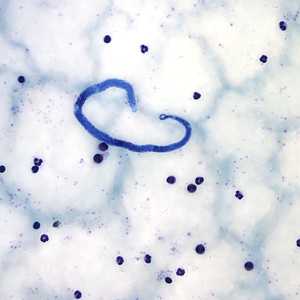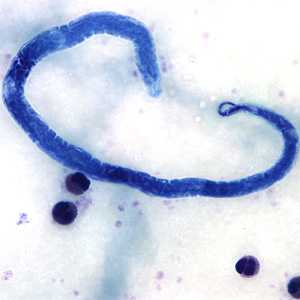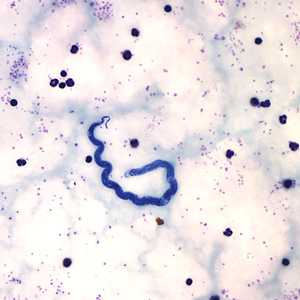
Case #161 - August, 2005
A 50-year-old returned to the United States after working with a missionary group in Mali and Senegal for 10 years. He went to a local hospital with a low-grade fever for 2 days. The physician ordered a blood film examination and thick and thin films were made and stained with Giemsa. Figures A-D show the objects, ranging in size from 236 to 245 micrometers, that were seen on the thick blood film. Figures A and C were captured at 400× magnification and Figures B and D were captured at 1000× magnification. What is your diagnosis? Based on what criteria?

Figure A

Figure B

Figure C

Figure D
Case Answer
This was a case of loiasis, caused by Loa loa. This case was diagnosed based on observation of microfilaria found on a Giemsa-stained blood film. Clinical presentation of an infection with Loa loa usually does not include fever and therefore the physician would have to perform other testing to determine the cause. Diagnostic features included:
- a short cephalic space.
- the size of the microfilaria, which was within the range for Loa loa. The actual size range for Loa loa is 250-300 micrometers, however in stained blood films some shrinkage occurs and consequently the size range can be decreased to about 235-250 micrometers.
- the presence of nuclei extending to the tip of the tail. Although the size range of L. loa can overlap somewhat with that of Wuchereria bancrofti (245-296 micrometers in stained blood films), the nuclei in the tail clearly differentiates L. loa from W. bancrofti.
Microfilaria of L. loa are sheathed, but it often is not visible on Giemsa-stained blood films; the sheath is usually visible on hematoxylin stained blood films.
More on: Loiasis
Images presented in the monthly case studies are from specimens submitted for diagnosis or archiving. On rare occasions, clinical histories given may be partly fictitious.
DPDx is an education resource designed for health professionals and laboratory scientists. For an overview including prevention and control visit www.cdc.gov/parasites/.
- Page last reviewed: August 24, 2016
- Page last updated: August 24, 2016
- Content source:
- Global Health – Division of Parasitic Diseases and Malaria
- Notice: Linking to a non-federal site does not constitute an endorsement by HHS, CDC or any of its employees of the sponsors or the information and products presented on the site.
- Maintained By:


 ShareCompartir
ShareCompartir